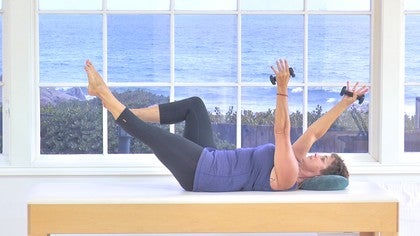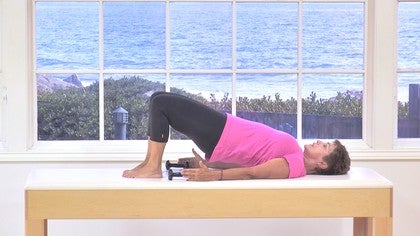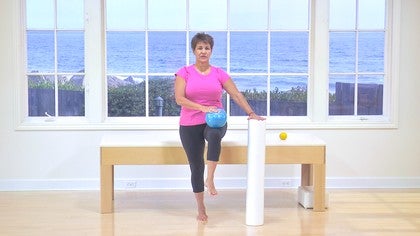Description
Watch Beginner Series 2 to add on to this series.
About This Video
Transcript
Read Full Transcript
This is a fundamentally focused workout where you will find fundamental exercises that will paint the picture for a larger plot. These exercises, you'll notice I have a weighted pole. I have a piece of fruit which is a lemon, which if you visit some of the tutorials that I've done on net position and stuff, you'll see why I'm using this and I'll state it again during the course of the workout. And I also have a bag of rice. You could also use a sand bag. You could also use a weight and I'll show you where to use those within within the workout. So we're going to start here by lying flat on your back. And if you remember by noticing the head position that you need to be in, you may have to be on a wedge. I'm just going to show you what that looks like. Again, we did this in the tutorial. I'm just repeating this briefly here.
You notice that we want to put the head and chest in a supported position so that one I lift one leg and lift the other leg. I don't do any lurching. So for some people they need to be propped up just a little bit. Okay. So I'm going to go ahead and take the wedge away. Some of you may not need that. In the first exercise that we're actually going to do, it's called sync the sandbag.
So we're going to lie flat on her back with the appropriate prop that you need under your head. I'm not having a prop under my head because I don't particularly need that. So I'm going to take this sandbag or this weight. I'm just going to put it right here on my abdomen and I'm going to breathe in. And then as I exhale, I'm going to relax my chest and shoulders and I'm gonna let that sandbag sink down.
My feet are not going to be so close in that it's going to make me arch my back because then I can sync the sand back. So I'm going to let my feet be a little further away. And again, the focus of this workout session is the fundamental focus. So we're gonna pay special attention to what's happening at the neck region and what's happening in the trunk region because a lot of times in a fundamental workout, we pay so much attention to a stable pelvis and spine that we actually forget to pay attention to what's happening in the neck. So I'm going to do a lot of self palpation and I'm going to do a lot of explaining about things to feel. So I'm going to start here with my right hand behind my head behind my neck actually.
And I'm going to let this sandbag sink my belly down. So I first want to feel as I breathe in and as I breathe out that no extraneous muscles are trying to help me.
So take another breath in. And as we exhale this time, the sandbags sinks. I almost feel a hollowing in my belly. And I just imagine that my belly button has a little vacuum in it and the vacuum is inviting maybe a little kernel of this rice, this whole bag of rice. Maybe it's inviting just a little kernel to come into my belly button. So I'm creating this little vacuum effect. Tiny, tiny, it's a little mini vac I like to say to my clients and not a Hoover vacuum.
Okay. It's just a little mini vac. So now I want to feel if that's disturbing my neck because for some people it looks like this. It's very subtle. So you may want to watch here in my neck and watch my shoulder. This is very subtle, but it's kind of cheating and it's a strategy that your body uses is that I vacuum in and I actually get this, this tension in my shoulder and my neck, but I'm trying like mad to keep my head facing the ceiling, but my right hand is feeling all the tension behind my neck. So I want to be really careful that I don't disturb that distance that's behind my neutral spine. And my neck.
So I'm gonna leave the sandbag here for a little while. My right hand is behind my neck. I'm going to take it inhale. And as I exhale, I'm going to let my left leg fall out to this side and then bring it back in. So right now you might be thinking, oh Ho hum. Here's another one of those fundamental workouts where I do a knee fallout, but let's pay attention subtly. Sometimes my knee falls out. That puts a rotation force on my trunk and I'm being careful here in my torso, but my neck starts to counterbalance. Okay, don't want that to happen.
That's my neck tensing really bad in the back. And then I need to bring my leg back. So I need to take a moment and regroup. I need to relax my neck and I need to not let my neck go into extension. So what I have to do is I need to take my little trusty lemon and I need you just to make a little connection here so that my entire face package, if you will, is what's looking up at the ceiling. And there's an ease in this face package, if you will. My head is settling back.
My brain is settling back, if you will. I know that's a big stretch, but I really want you to let go of any extraneous movement in the neck and then I'm going to let my leg of fallout and I'm actually working quite hard to not move my neck, my chest, or my shoulders. Right leg out. Sync the sandbag, bring it back. Yeah. Okay, one more time. Left leg out returns, right leg out returns. Now I take this short lever arm and I lengthen it down so I slide my leg out long. Oftentimes what happens when I slide the leg out long is the body kind of goes into extension and the head wants to go back and then the person tries to change it with their head and shoulders, but what happens is they don't change it enough so that they have an ease of movement here while the leg goes out and in. I'm going to put my lemon back because that gives me great feedback and I'm going to do the heel slide back in. I'm going to take a right heel, slide out without disturbing anything. As I exhale, the sandbag sinks, my throat kind of sinks if you will, and I don't have any extraneous movement in my head or my chest or my shoulders.
I'm going to do that one more time on the right and one more time on the left. Notice how that feels in your trunk. There should be an ease of feeling here in your upper torso. If you have not been feeling that ease, then you may need to prop yourself accordingly. So go ahead and take that time. Now if you need to do it, just hit stop and go back and get an inappropriate prompt for your head.
It may even just be a towel for now to start with, but go ahead and do that and then bring yourself back. So if you're back now or you've continued on, I'm going to go ahead and take this out just so it doesn't get irritating for you and you don't have to put a lemon there. I'm just saying, I'm just showing you how it makes a nice connection. So now I'm going to make this fundamental a little bit harder and I'm going to lengthen out my leg because now I know that I am going to let go of my old strategy and I'm going to try to prepare a new one, which essentially says, meltdown. Relax. I'm going to take my hands onto my tummy because sometimes when my hands are by my side, I tend to use my arms to give me some sort of false sense of stability. So I'm actually going to take my hands out of it and I'm just gonna lay them on my tummy.
I'm going to hover this leg off the ground. I'm actually going to try to pick my leg up, but I can't. You try to pick that left leg up, but you can't and it makes a nice connection into the trunk. I'm going to melt my face backwards into my head, into the mat or into whatever it is you're on, and I'm going to have that leg up after I try to pick it up and I can't, and then all of a sudden I can mend it. Inhale, lower it down, exhale, melt. Everything melts. The neck is not overworking. The stabilizers deep are working and then I lower that leg down my bin, that knee in. Try it with your other leg. Take your time, take an inhale, exhale, melt.
Remember what you're doing here in this lesson is you've invited yourself in to the classroom and I call that classroom your body, and what I want you to do is just take a notice of everything that's happening. Inhale here to prepare yourself. As you exhale, try to lift your right leg up off the ground, but you can't lift it. It's stuck down. Organize around your core, gently activate your deep abdominals, your pelvic floor even comes in, not the neck. You could even take your hand and put it here on your neck and take your other hand and put it behind your neck and make sure that when you lift this leg up that nothing changed or tense externally and then you're going to lower that leg down. Isn't this indeed single leg circle as I lift this leg all the way up to prepare for single leg circle, which we'll do in another workout we're not going to do right now, but this is what this exercise becomes, is no disturbing anything while that leg is up in the air and then we're going to bring the two knees back and relaxed down so you can do a myriad of other things with your legs, knee fallout and in one leg lifts and then the other is our next version.
Sandbag sinks down, make a connection and the deep neck, I'm not pressing my head back maximally. Can you see how that is? Kind of almost like a shearing backwards so I'm not doing that again. What I'm doing is I'm just making a gentle load if you will, on my deep neck flexors and I lift one leg up. I'm going to sink the sandbag without lurching and I'm going to lift the second leg up. This is very hard. Take an inhale as you exhale. My sandbag sings, my thighs squeeze together, my arms are on my abdomen.
They can of course be down by my side if that doesn't disturb anything. And then I lower one leg down and then I lower the other lake down. And you'll notice that my voice didn't change while I was talking either. That's actually another good sign that everything is staying connected. We're going to do that same exercise again with a very typical fundamental we call marching or toe taps.
And I'm going to show you sometimes what happens is we take one leg in, we lift the other leg in, we start to lower one leg down and maybe you hear somebody say, okay, lower down, lower down, lower down, lower down, lower down. Who Don't move your head lower down. Okay, so now we've not moved my head, but I've moved everything between my head and my spine. I need to stop the exercise and I need to regroup. So the lemon helps. You can put your fist underneath there just to remind you, I'm going to take one leg in, no lurching other leg matches. And so now as I lower one leg down for that very infamous toe tap, I notice that I can't go and toe tap all the way to the floor.
And that's okay. I'm only gonna toe tap to the distance that I feel sufficiently challenged and that I feel I don't get into an old pattern because I don't want to reinforce the old pattern. And then that exercise, whew, becomes really, really tough. So that's how we lift the second leg without the lurching. There's a strategy you can use that also helps. It looks like this.
I'm going to lift my right leg up and now since I've organized my head and neck and I understand how that works, I'm going to take my same side arm and put it behind my thigh. Press that file away to create the strategy in my hamstrings and my glute region on the right. Sync the sandbag without changing this neck position and then lift the second leg up. So now my hands have asked my glute in my hamstrings to come into the party and stabilize and then I lower one and then I lower the other. So one more little variation here and watch the sandbag because sometimes you put a sandbag and it's just not heavy enough.
Sometimes we just can't have enough sand or enough rice to hold that belly down. So I'm going to do it wrong because sometimes it helps to see that as well. I promise I won't hurt myself. I'm going to take one leg in and then all of a sudden, whoa, there it goes up the sandbag there comes up second leg. But by Golly, I didn't move anything. You see my boys change. Oh my goodness. And then I have to stop and stop and then I got to regroup.
So now I'm going to see if I can change that. I won't be so difficult to see. I'm going to let the bulge happen. But now watch the sandbag.
And then from here I can vary. And then doesn't this become double leg, lower or corkscrew? With a sinking sand bag and a sinking face that, that, that sounded really silly, a sinking face. But I think you understand what it is I'm saying. I want the belly to sink down. I want the face to be soft. This is really hard. Claudius is really good, y'all.
And then I'm going to hold this right here and then I'm going to lower down and lower everything down. So that's a way that we have to understand and organize the neck position during exercise. Okay? So the next piece of this fundamental workout will be with movement. So I'm going to take these props and put them away. I'm going to take this little neck pillow. I'm going to lie myself down.
I'm going to put this little neck pillow kind of behind my neck and my cervical spine. Recognize my neutral, my melting belly, my face resting back. Now very typically in our fundamental workout, this neck is also going to give my back of my neck feedback. So now I'm going to start the invitation to my spine and I'm not going to turn my head side to side to speak with you because it'll change the mechanics of my spine. So I'm going to stay looking straight ahead. I'm going to take an inhale and then as I exhale, my abdomen sinks the sandbag that I've already created.
I make an invitation to my pubic bone to curl up, or if I need to speak to the back of my body, my tailbone to curl between my knees. You can use whichever Q you want as long as your body understands it. Inhale, exhale, sink the sandbag tailbone curls, pubic bone lifts. I try to come up a little bit higher. I personally am paying careful attention to what's happening to my neck because sometimes in my own zest or my own enthusiasm to curl the tailbone, I actually press the back and then the neck does this, which is not what we're looking for. So we have to go back and recognize that as our own strategy, our own misinformed strategy.
I'm going to put my thumb kind of on my sternum and my pinky finger pointed down below my belly button. And now I'm going to do this same fundamental awareness with my neck. So I'm going to take the axis of motion actually that happens here at the ear. And I'm going to let my eyes glance upward as my nose and my chin follow. Sometimes we've done this in the Feldon Christ workout and then as my eyes follow the ceiling and my chin and nose come down, the back of my leg, neck lengthens, and then I bring myself to level again.
Inhale, I feel my head is staying on the ground. I'm lengthening my cervical spine in the front. And then as I exhale, I'm lengthening the back of my skull as my cervical spine lengthens this way. So again, as my chin and my nose and my eyes paint an arch on the ceiling as I go over, nothing is moving down below, but I'm teaching my head how to rotate on the top of my spine. I have not even lifted my head up off the floor, so I've just taken these movements and taken them through their range of motion to kind of organize the spine and recognizing the normal curves in the cervical spine and the normal curves in the lumbar spine.
So then I go back now and I melted in this nice position here, which is neutral position. So now I'm going to challenge this. I'm going to take these hand weights. So now with the hand weights up in the air, I'm going to let the weight of the weights kind of drop my shoulders down into the socket, which doesn't mean let my chest come up. Okay? It just means drop the shoulders down. I can give myself a little reminder with one of the weights here.
Sinking the sandbag. So now arms come over the head with an inhale and then arms come back to the ceiling with an exhale. Inhale, the neck position doesn't change. The face position doesn't change. An exhale back an inch or two, pause and then come back an inch or two, pause and then come back an inch or two. Pause. And then again, inhale back, exhale, return. How do I make this exercise harder? I could lift one leg up, I can move the weights back and the weights forward.
I can move the weights and the arm. I can move one arm and one leg. This right here is a big challenge for the core. We understand this from our viewpoint as instructors, but as a person, if you're doing this for the first time at home, what I want you to pay special attention to is what's happening to your abdomen and then what's happening to your neck. Because again, sometimes in our own zest to get a stronger core here, we forget about the neck and its relationship to that. And then we can do it like this. So I can leave my weight here. Inhale, go back, exhale, come up.
So our most advanced then fundamental would be one leg in other leg matches my head melting back. And then we would alternate one and then return and then one and then return. And then watch this. Here's the big one too. But I'm not going to go much further out than this because what's going to change on me is my neck. So inhaling and then exhaling and then everything comes down. So all that we understand as core fundamentals, PyLadies principles. But now we have to lift the head.
Okay. So now I need to get my trusty lemon again. So I'm going to bring myself up and I put the weights away. Lie Back Down. And if you're at home, you could have been doing five other repetitions of those legs away and then you can join me again. Now for the head left. Okay, so now I'm going to put this my hat under here. Actually, just a second. You know how many of you at home, when you lift your head and curl your trunk, your neck is what bothers you the most during a trunk curl.
It used to happen to me all the time. And then there was the old school, um Oh, where you make a diamond and put your hand behind your head and you did this business, which is just a one big accident waiting to happen in your neck. So we don't want to do that. But that's kind of an old school thing. And we have to again learn how to engage this deep neck. So I'm going to not only use the lemon, but now I'm going to lace my fingers. I'm actually going to put them behind my head, sync my sand bag. And now when I go to curl my trunk, I first have to engage this business of my head or my skull, if you will, in a in one book it's called Capita, which is another name for a head. But it's your head moving on your, on your skull moving. Excuse me, on your first cervical vertebrae.
Notice I haven't even lifted up my head yet. And then from there I need to lift my head. I'm going to do two different movements and I want to see if you can tell me the difference or if you can tell yourself the difference. Here's my forehead and my face lifting towards the ceiling. Here's my forehead following my nose, which follows my chin, which doesn't even lift my head.
And now once I have all that organized, that was just a head lift. Your head weighs 10 to 12 pounds. So it takes core stability to support your spine in order for your head to lift. And then and only then can I curl the trunk when I lower myself back down, if I let my head go, the lemon might roll out, but then I get the head back. We don't want to do that.
I have to take time to unroll my spine. My eyes are glancing between my thighs, and then my neck goes down and then my head softens. We know that articulation of movement through our bridging in our lower back, but now we're reusing it here. So again, in this fundamental sequence, I make my back of my neck long, which we say a lot. We say length in the back of the neck, but sometimes I wonder if the clients really understand length in the back of the skull and sometimes remember, I'm not propped right now, but remember some of you may actually need a prop or a wedge or that Bosu. So here it is again, lengthening the back of my head, lifting my head, curling my trunk. Notice my pelvis is flat, I'm curling my trunk.
Now guess where all the work is?
I can get myself out of it because that's what we have to be able to do because there are times when our body gets called to do something in a beret pattern, maybe in a hurry. Let's do three more of these together. Lyft, this time. Let's do it on an inhale so we can use that intallation to expand the back ribs. Inhale, exhale. Inhale,
And we're going to do it while we sit on the long box. So this is going to be a curl back and a hinge back. And this gets us set up for our roll back in the mat work and it gets us set up for our work on the reformer short box on the reformer. So however you set people up here, you can put something between the legs and things like that. But what we're going to work on here, again, because what we're talking fundamentally is about how we organize the neck. Um, and the overwork of the neck versus the overwork in the back.
So the first thing, what I like to do here is help clients understand in this sitting position the difference between their belly and their back. So I'm going to take one hand and put it right on my abdomen, and I'm going to take the other hand and put it in my low back and take an inhale. And as I exhale, I'm going to pull my abdomen or vacuum my belly back from this hand. In essence I'm doing is sinking the sandbag, but I don't have a sandbag here.
Your deep multifidi muscle are working, of course, to maintain that neutral. But at no time are you pulling back. So let's keep this here and now let's take the information to our head and our neck. So I'm gonna take one hand on my chest and one hand here. And I don't know if you've noticed this because some things I do on purpose to make a point, but some things I don't, and you might just notice them on me. I tend to use in my own strategy, my own Karen Voice Strategy. It's not a correct strategy, but my strategy says this lifts me up.
But that's my net going back. Okay. So I have to develop that awareness in the front of my neck so that the whole lift has to come up. The axial skeleton, which is the center part of your spine. So I'm going to place one hand here on my chest and one hand behind the small of my neck and to take an inhale, and then as I exhale, I'm going to sink the sandbag, not use my neck muscles and just see if I can take the crown of my head up without disturbing anything else. Inhale again. And then exhale with ease scooping in the belly, softening the neck. So now from here, I'm gonna take my arms out in front and I'm gonna take an inhale. And as I exhale, I'm going to curl my tailbone, which I've learned how to do on the Mat, and I'm going to roll my abdomen back as I neither drop my head forward or back.
The next piece of this is a hinge back. So first we have to understand the difference between the hinge and the round. So for that, I need one other little prop. And you can do this on yourself or you can do it with a pole. You can actually do it with a short box pole.
But I'm gonna use this little yardstick.
So I have my neck space, I have my low back space. And again, so now as I do a hinge, I need to do a hinge and I need to pay attention to what's happening here. So this is not a hinge, that would be an arch. This is not a hinge that would be a teeter totter. So I'm gonna maintain the position of this stick as I hinge back and then hinge forward. I'm going to take my lemon because that helps my neck. I'm going to hold it, I'm going to hinge and then come forward.
I'm going to take the stick away just so that for the sake of the exercise, it looks like this. Have you seen this in other exercises? One more time, maintaining the position of the neck and the trunk through all those movements. So hopefully in this little fundamentally aware class you can create these fundamental positions that will then carry over into, um, applaud Hazmat class. Or actually I'm going to teach another class, which would be the second class in this series and it will be all these kind of a little bit quicker, but not rushed. Just a little bit more of connecting the dots, if you will.
Since you've done this workout several times, you kind of know what your cheating strategies are and you kind of know the kind of strategies that you want to do to create better connections. So be sure and join me for the next class as well. Thanks.
Key Connections: Mat Fundamentals
Comments
You need to be a subscriber to post a comment.
Please Log In or Create an Account to start your free trial.





































